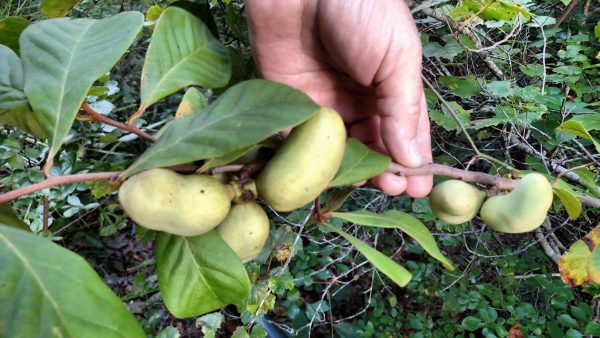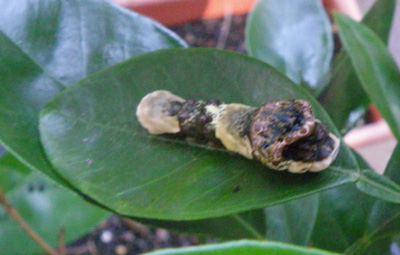Pawpaw

Asimina triloba
The Pawpaw is a native American fruit found in Zones 6a to 8a. It grows as a small tree with a short trunk and spreading branches, forming a rounded crown.
• More detailed information can be found in The Georgia Fruit & Vegetable Book by Walter Reeves and Felder Rushing
• See also Home Garden Pawpaw
Trees grow to 30 feet high and half that width. The leaves have a medium green upper surface and a lighter green lower surface; they tend to droop, giving the tree a sleepy appearance during the summer.
Pawpaws are borne in clusters of one to six. Fruit size varies greatly, 2 to 6 inches long with an elongated or rounded shape. Pawpaw fruit have a very thin green skin, which turns yellowish-black when ripe, like an overripe Banana. Fruit ripen from September until frost. After ripening, fruit soften and perish rapidly. The flesh has a rich, sweet custard consistency. They are most commonly described as tasting like Banana combined with other fruit. There is a considerable variety of flavors among wild Pawpaws. Ripe Pawpaws should give when squeezed gently, as ripe Peaches do and can be picked easily with a gentle tug. Ripe Pawpaws usually give off a powerful fruity aroma, as well.
Pawpaws do best on fertile, well-drained soils that are slightly acid. They do well in full sun or dense shade. Transplanting is difficult and should be done when trees are less than a foot tall.
Varieties to look for: ‘Davis,’ ‘Mango,’ ‘Mitchell,’ ‘P A Golden,’ ‘Sun-flower,’ ‘Taylor,’ ‘Taytow,’ ‘Wells,’ ‘Wilson’ and ‘Overleese.’
Pawpaws are self-infertile requiring another cultivar or non-related wild plant for cross-pollination.
For more information on Pawpaws, see Kentucky State University’s Pawpaw Planting Guide.
















